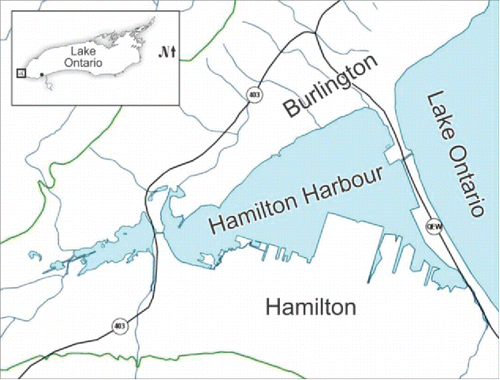It is with mixed emotions that I present to you the current special issue: State of Hamilton Harbour ecosystem: Health, remediation and restoration. Though I am pleased to offer a comprehensive assessment of Hamilton Harbour, an embayment of Lake Ontario with a reputation of being polluted, Hamilton Harbour is not just the focus of our research activities, it is also where we choose to work, live and raise our families: it is our home. This personal and professional connection is apparent throughout this special issue.
Hamilton Harbour covers 21 km2 on the western end of Lake Ontario with a maximum depth of 24 m. The harbour has a long history of contamination from urban and industrial growth dating back to the 1800s. It is a physically disturbed and highly variable ecosystem due to the hydraulic exchange with Lake Ontario and frequent navigation by large vessels (Harris et al., Citation1980; Haffner et al., Citation1980). By the early 1980s, improved waste water treatment facilities had somewhat decreased chemical inputs, but municipal and industrial loadings were still high making Hamilton Harbour a hyper-eutrophic ecosystem (Munawar et al., Citation1991; Munawar and Fitzpatrick, Citation2011). Water and sediments were found to be highly contaminated with metals, oil, grease and polyaromatic hydrocarbons (PAHs) in the vicinity of steel industries (Poulton, Citation1987; Harlow and Hodson, Citation1988; Metcalfe et al., Citation1988; Krantzberg and Boyd, Citation1992).
Subsequently, Hamilton Harbour was identified as being one of the most degraded ecosystems of the Great Lakes (IJC, Citation1985). Based on the violation of Beneficial Use Impairments, the harbour was classified as an Area of Concern in 1987, 1 of 43 to receive this designation (IJC, Citation1987). This necessitated the development and implementation of a Remedial Action Plan (RAP) which was meticulously documented by Hall et al. (Citation2006). Apart from research and monitoring, the RAP process also emphasized the importance of communicating results. The publication of these Hamilton Harbour special issues (Part I and II) in our journal, Aquatic Ecosystem Health and Management (AEHM) is part of this communication strategy, prudently initiated by John Hall, coordinator of the Hamilton Harbour RAP.
This special issue was organized by a team of experts familiar with the Hamilton Harbour watershed. An initial committee including, Duncan Boyd (Ontario Ministry of the Environment and Climate Change), Marten Koops (Fisheries and Oceans Canada), Chris Marvin (Environment Canada) and Ken Minns (Fisheries and Oceans Canada, emeritus), developed a list of potential contributors who would cover physical, chemical and biological components of the harbour ecosystem.
The Aquatic Ecosystem Health and Management Society (AEHMS) carried out the organization and coordination of the publication. Potential contributors were invited by the AEHMS to submit abstracts and a meeting was convened in May, 2013. Based on this informative meeting, papers were selected for presentation at the author's workshop in November, 2013. Following this workshop, manuscripts were selected by the organizing committee for submission to the AEHM journal. All manuscripts were subjected to meticulous peer review, revision by the authors, check-ups by the editorial committee and then technical and linguistic editing by the AEHMS technical editor.
This special issue, the first of two, contains 11 articles which have been arranged under broad subject areas including: Physical-chemical regime (3), Toxic contaminant dynamics (5) and Biotic community dynamics (3). The second special issue is in progress and will include additional articles dealing with the ecology of the harbour and its dynamics. We hope that the state-of-the-art content of both of these publications will be useful for the RAP process, especially the managers, scientists and students who are involved in research and monitoring efforts aimed at the remediation and restoration of the healthy environment of our harbour ().
On behalf of the AEHMS, we would sincerely like to thank John Hall and Kristin O'Connor of the Hamilton Harbour RAP and the expert committee for their contributions and support in the development and organization of this special issue. Thanks are also due to Rimi Kalinauskas of Environment Canada for arranging funding for this publication.
A note of thanks to Jennifer Lorimer, Lisa Elder, Susan Blunt and Mark Fitzpatrick for their assistance in various aspects of this publication project.
References
- Haffner, G.D., Harris, G.P., Jarai, M.K., 1980. Physical variability and phytoplankton communities III. Vertical structure in phytoplankton populations. Archiv. Hydrobiol. 89(3), 363–381.
- Hall, J.D., O'Connor, K., Ranieri, J., 2006. Progress towards delisting a Great Lakes Area of Concern: The role of integrated research and monitoring in the Hamilton Harbour Remedial Action Plan. Environmental Monitoring and Assessment 113, 227–243.
- Harlow, H.E., Hodson, P.V., 1988. Chemical contamination of Hamilton Harbour: A review. Can. Tech. Rep. Fish. Aquat. Sci. No. 1603.
- Harris, G.P., Piccinin, B.B., Haffner, G.D., Snodgrass, W., Polak, J., 1980. Physical variability and phytoplankton communities I. The descriptive limnology of Hamilton Harbour. Archiv. Hydrobiol. 89(3), 303–327.
- International Joint Commission (IJC), Great Lakes Water Quality Board, 1985. 1985 Report on Great Lakes Water Quality, Kingston, Ontario, Canada.
- International Joint Commission (IJC), 1987. Revised Great Lakes Water Quality Agreement 1978: Agreement, with Annexes and Terms of Reference, between the United States of America and Canada, signed at Ottawa, November 22, 1978 and Phosphorus Load Reduction Supplement signed October 16, 1983: as amended by Protocol signed November 18, 1987, Windsor, Ontario, Canada.
- Krantzberg, G., Boyd, D., 1992. The biological significance of contaminants in sediment from Hamilton Harbour, Lake Ontario. Env. Tox. Chem. 11, 1527–1540.
- Metcalfe, C.D., Cairns, V.W., Fitzsimons, J.D., 1988. Experimental induction of liver tumours in rainbow trout (Salmo gairdneri) by contaminated sediment from Hamilton Harbour, Ontario. Can J. Fish. Aquat. Sci. 45, 2161–2167.
- Munawar, M., Fitzpatrick, M., 2011. The application of Vollenweider's eutrophication models for assessing ecosystem health: Hamilton harbour (Lake Ontario) example. Aquat. Ecosyst. Health Mgmt. 14(2), 204–208.
- Munawar, M., Leppard, G.G., Munawar, I.F., 1991. Ecotoxicology of stressed environments: Structural and functional strategy. Verh. Internat. Verein. Limn. 24, 3080–3086.
- Poulton, D.J., 1987. Trace contaminant status of Hamilton Harbour. J. Great Lakes Res. 13(2), 193–201.

